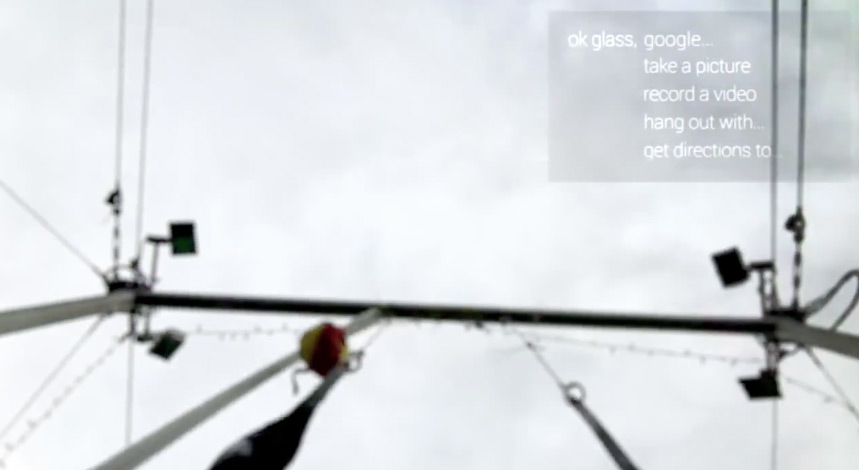Impressions of working with Google Glass

Dustin Curtis tried to describe most fully and impartially the experience of using the Google device, which soon, as search giant giant co-founder Sergey Brin hints at , would radically change the way we use smartphones.
The characteristics of glasses have long been known . In general, they are a smartphone-like (dual-core TI OMAP 4430 1.2 GHz processor, about 1 GB of RAM) headset (glasses do not have a GSM or GPS / GLONASS module), the hallmarks of which are a projector with a probable resolution of 640 × 360 pixels, voice control, vibration transmission directly into the user's skull, 5-megapixel camera, touchpad on the side and a set of accelerometer, gyro sensor and magnetometer. Points are running Android version of the fourth version using Google Now.
')
To this information, Dustin was able to add an interesting time to many points. The developers and enthusiasts, who were given at the mercy of one and a half thousand dollars for a model, have an unacceptably low price: with constant work, the glasses work for about 2 hours, and in 10 minutes it took 8% of the battery charge. It is hoped that in the future the glasses will work much longer, easily pulling for 12 hours. In general, Dustin was pleased with the appearance of the glasses, calling them a step forward, although he considers the device somewhat "raw."
For the first time wearing glasses on a sunny day on the street, Dustin unexpectedly could not see anything. The projector is made on the basis of a photochromic lens that dims the daylight, but the user still has to constantly look into a dark place, and the screen brightness leaves much to be desired. It is also difficult for the addictive to mow the eyeball (and not to turn the whole head) to the area where the projector is located.
Points communicate with the user a little voice, basically everything is displayed on the screen; this is probably due to the fact that developers are planning to use other input-output devices like MYO from Thalmic . Because of the listed features, it is difficult and dangerous to use maps and navigation while driving: in order to distinguish something, you need to focus your eyes on a nearby object, and look in a dark place, not on the road.

In promotional videos and photos, glasses in the standby state, as a rule, show the current time. In reality, the prototype is always disabled, and to enable it, you need to touch the touchpad or nod an affirmative. In the first case, the glasses will emit a signal of readiness for work, offering to say something. If the user does not call the team for a short period of time, the glasses will turn off, and you have to nod and ask “OK Glass” as if you were having a fit. Dustin spoke very positively about speech recognition: the glasses did not make any mistakes in recognizing the commands from the set available.
A set of commands leaves the impression of something still unfinished: for example, “OK Glass, take a picture” will force the headset to take a photo, while the phrase “OK Glass, take a photo” will be ignored. The prototype will also not respond to “Next” or “Previous” when navigating the menu and will not respond to the seemingly simple “Share this photo”. This is probably a consequence of speech recognition optimization.

Like the jokers, if the glasses are activated, then anyone can control them, including the non-owner. A prankster can make glasses take a photo or search for something in Google. “Glass” lives its own life in the matter of shooting: the glasses themselves choose the right moment a second sooner or later the voice command and take a picture. By the way, the search thanks to Google Now is very convenient, for example, “OK Glass, Google“ How tall is the Empire State Building? ”” Will display a card with the image of the building and the answer. Any other requests that are not included in Google Now are not so convenient, since the search results will be shown on the points projector, including one sentence from the page previews. To open them without a smartphone is impossible.
The points interface is unintuitive, and for the first time it is very difficult to use them: up-and-down movements scroll through menus (but not everywhere), and forward-backward movements scroll through application windows or action history. Other users note that no additional help was needed to sort them out. Glass rarely offers the option of selecting a menu item by voice. The scrolling methods differ by the way the menu is opened (by voice or touchpad), which confuses the user. For some reason, glasses do not respond well to scrolling.
Pleasant impression on Dustin made the translation application, which, however, also did not remain without complaints: instead of displaying text or transliteration on the screen, glasses say the text in voice. It is not always possible to perceive speech by ear or repeat a phrase in an unfamiliar language, especially since the volume and sound quality is low. Ambient may hear distorted noise when playing a sound, which in some countries is unacceptable by the rules of etiquette.
In general, the glasses made an impression on Dustin of an item from the future worth not less than a thousand dollars. But wondering if they are the human-computer interface we need, he comes to the conclusion that Glass is still far from him.
Source: https://habr.com/ru/post/181568/
All Articles